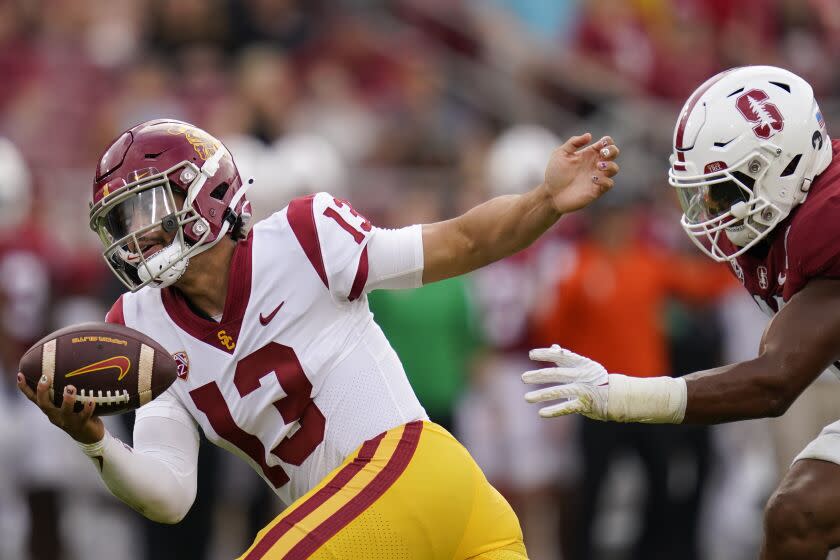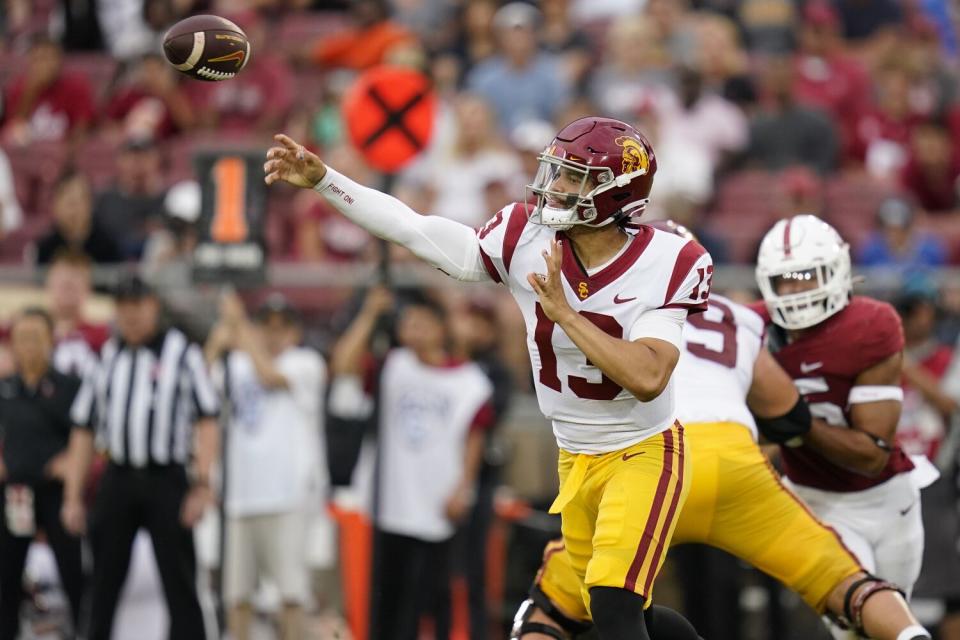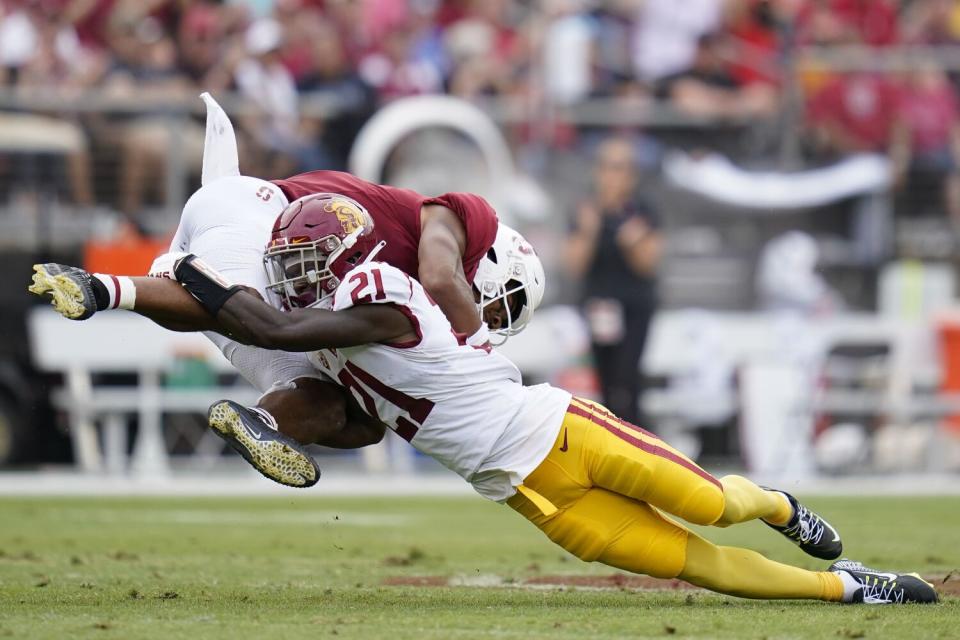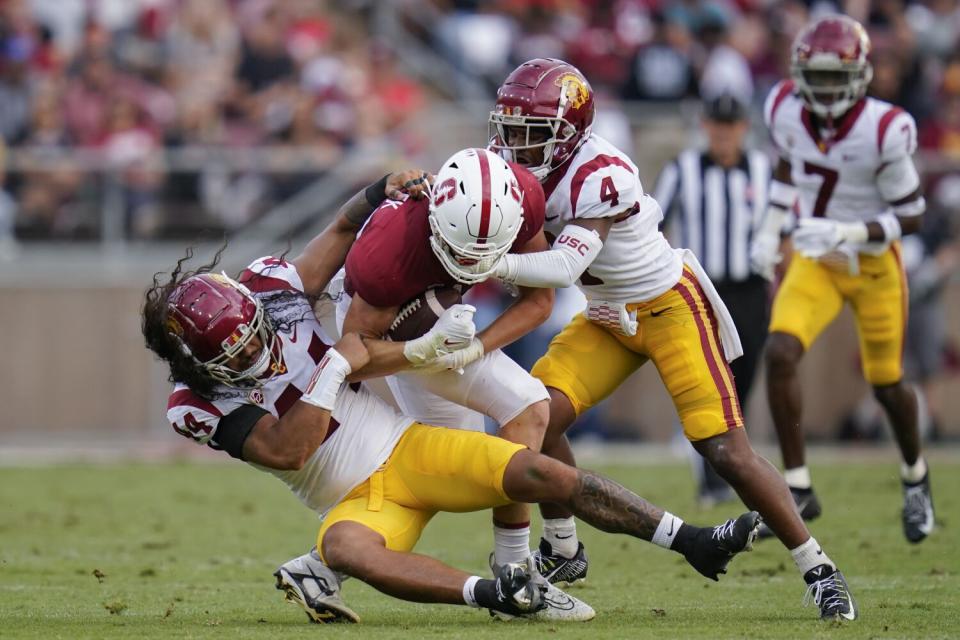Caleb Williams Heisman hype surging: Takeaways from USC's win over Stanford

When the negatives about USC’s 41-28 win over Stanford snuck in Lincoln Riley’s head — the sluggish second-half offense, getting gashed by Stanford’s running game, a missed field goal — the coach warded them off by remembering where this team came from.
“Look at 12 months ago,” he said repeatedly.
On this same weekend in last year, USC got rolled by Stanford at the Coliseum. It cost the Trojans their coach. It upended the entire season. It led to Riley’s eventual hire.
From those ashes, the Trojans built a team that looked at times Saturday like a juggernaut on offense and won at Stanford for the first time since 2014.
Here are four takeaways from the game:
Caleb Williams Heisman Trophy train gaining steam

Caleb Williams began the season as a top-three betting favorite for the Heisman despite not even starting an entire season at quarterback last year with Oklahoma. He’s making those oddsmakers look very smart.
The quarterback elevated his excellent play to a nationally broadcast, prime-time TV slot with 341 passing yards and four touchdowns. He completed 20 of 27 passes Saturday. Combined with his 19-for-22 performance against Rice, Williams has competed 79.6% of his passes through two games with no interceptions.
Williams has the Trojans winning and the fact that he did so in such a stylish way in front of a national audience should help a Heisman campaign that’s equal parts hype and performance.
Williams showed his mastery of the USC offense by expertly checking out of a play in the second quarter, changing the call at the line to evade what looked like an oncoming Stanford blitz. The result was a wide-open running lane for Travis Dye, who went 27 yards untouched. When asked of the play, Williams credited the heads-up call to Riley, who bashfully gave credit back to the quarterback.
Pedal to the metal

It wasn’t all perfect from an offensive perspective. After a dynamic first half in which USC flew to a four-touchdown lead, Williams and Co. clearly let up in the second. The quarterback started Saturday 14 for 16 only to finish six for his last 11. The rushing attack accumulated more yards in the first quarter (49) than the entire second half (42). Altogether, the Trojans averaged 11.1 yards per play before halftime, then just 4.6 yards after.
“We just took the foot off the pedal and we shouldn’t have,” Dye said. “We all know that. We took it off just for a little bit. We just have to put it down their throats all the way for four quarters.”
Riley also was quick to point out that problematic trend, saying it “wasn’t up to our standard.”
“Wasn’t very good by me, wasn’t very good by the offense in the second half,” Riley said.
How sustainable is this defense?

Two games into the season, the Trojans are making Alex Grinch’s goal of 24 takeaways look like an extremely low bar. USC is already one-third of the way there after four more takeaways — two interceptions and two fumble recoveries — against Stanford. The Trojans also haven’t committed a turnover.
The eye-popping plus-eight turnover margin may help cover up the fact that Stanford was averaging 6.4 yards per carry through three quarters Saturday. Last week's four interceptions — which included three pick-sixes — eclipsed a first half in which Rice averaged 6.7 yards per carry.
“Say what you want but this USC defense figuring out ways to create turnovers,” former USC quarterback Matt Leinart tweeted. “That’s a real thing.”
Say what you want but this USC defense figuring out ways to create turnovers. That’s a real thing. Some rises it’s tough, some years it become contagious.
— Matt Leinart (@MattLeinartQB) September 11, 2022
But Riley can't let it be enough to support the defense all season. The coach attributed the defensive lapses to mental mistakes that easily could be cleaned up. When asked if the miscues were a byproduct of a newly assembled team still finding its way, Riley rebuffed any suggestion that he would use time as a “crutch.”
“I’m not going to be the guy to sit here right now and say, ‘Well, it’s just not good enough because we haven’t had enough time,’” Riley said. “No excuses. We can play the calls better, we can coach better.”
Max effort

At this time last year, Max Williams already was well into his long recovery from a torn knee ligament, wondering when he finally might be able to push his way back to the field.
On Saturday, the USC safety made his presence felt from the start, picking off a tipped pass for the first of four Trojans takeaways. He later forced a fumble inside the five-yard-line from Stanford’s E.J. Smith.
Both plays set an important tone on a defense that needed right plays at the right time.
“This guy in a lot of ways embodies what we want in this program: a toughness, an edge,” Riley said. “He’s been an absolute warrior for us.”
This story originally appeared in Los Angeles Times.

